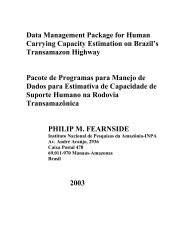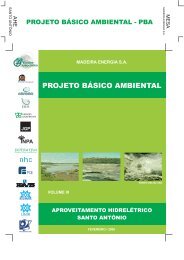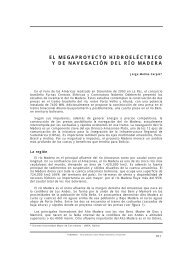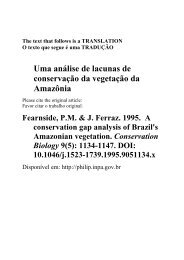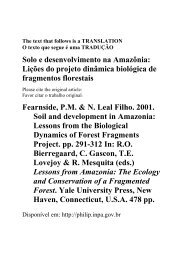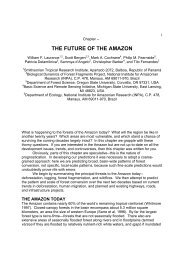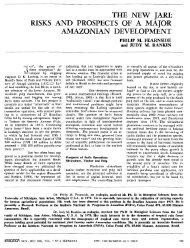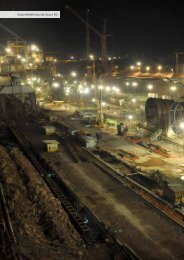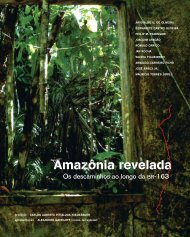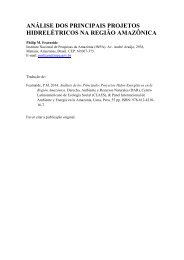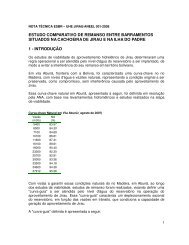kin, <strong>19</strong>85: 121). Jari now harvests itsGmelina <strong>at</strong> the young <strong>age</strong> of 3-4 yearsto avoid the fungus, which has becomemore severe. In the case of Gmelinagrown from stump sprouts, or coppices,early cutting is also wise due to weakgrowth after the fourth year. Shortenedrot<strong>at</strong>ions imply substantial increases inproduction costs: planting, weeding andharvesting oper<strong>at</strong>ions have to be doneregardless of rot<strong>at</strong>ion length.The Cer<strong>at</strong>ocystis fungus<strong>at</strong>tacks coppiced Gmelina more severelythan Gmelina planted as seeds or seedlings.Since coppiced Gmelina growsfaster than trees planted from seed (inthe first 4 years), J ari's man<strong>age</strong>rs hopeth<strong>at</strong> sufficiently resistant stock can bedeveloped to allow use of the coppices.Coppiced Gmelina would also be advant<strong>age</strong>ouson the more steeply-sloping sitesto minimize erosion between crops.Breeding continues in ayet unsuccessful effort to develop linesof Gmelina resistant to Cer<strong>at</strong>ocystis. Jari'spast successes in improving Gmelinagrowth form are being transferred to theplant<strong>at</strong>ions in the Gmelina th<strong>at</strong> is notallowed to grow back as coppices. Thelimited size of the present seed orchardhas cre<strong>at</strong>ed a short<strong>age</strong> of improved seedstock. A 70 ha area in a commercialstand is now being thinned for conversionto an additional source of seed.Gmelina is being innocul<strong>at</strong>edwith Cerawcyszis fungus insome parts of the commercial plant<strong>at</strong>ionsin an effort to select resistantstock. Experiments are also underwayin which infected trees are cut and leftin the plant<strong>at</strong>ions (r<strong>at</strong>her than being removed)in order to see if this cheapermeasure would be sufficient to controlthe fungus.A new fungus has appeared<strong>at</strong> J ari, <strong>at</strong>tacking 100 ha ofGmelina in October and November <strong>19</strong>85.The as yet unidentified fungus causedleaves to fall off the trees, but the treessurvived and the leaves have since grownback.Applying fertilizers tocommercial Gmelina plant<strong>at</strong>ions, begunin <strong>19</strong>82 (<strong>Fearnside</strong> and Rankin, <strong>19</strong>85:123), has been discontinued. The cost ofbalancing nutrient removals will eventuallyhave to be paid if production is tobe sustained.Bulldozing to removestumps, known as "intensive site prepar<strong>at</strong>ions,"is being done <strong>at</strong> a r<strong>at</strong>e of 3000-4000 ha/ year, which is as fast as Jari'scurrent capabilities allow. At this r<strong>at</strong>e itwould take 25-33 years to destump the approxim<strong>at</strong>ely1 00,000 ha area deforestedso far. Jari's man<strong>age</strong>rs do not plan todestump the steeply-sloping areas, wherethe erosion hazard is gre<strong>at</strong>est. However,the staff fear th<strong>at</strong> increasing costof manual labor will eventually makeunmechanized use of the steeply-slopingareas uneconomic.J ari's silviculture staffacknowledge th<strong>at</strong> they will not be ableto plant more than a very few cycles ofGmelina on the steeply-sloping sites dueto erosion. If man<strong>age</strong>ment of the resprouts(coppices) proves impracticaldue to the Cer<strong>at</strong>ocystis fungus, then thesesites will either have to be abandonedor converted to a perennial crop (oilpalm, etc.) or to a long-cycle rot<strong>at</strong>ionof hardwood species. Tests with perennialcrops (cacao) and planted hardwoods(teak) were discontinued underthe previous administr<strong>at</strong>ion when theyproved uneconomic (<strong>Fearnside</strong> and Rankin,<strong>19</strong>80).Jari already has abandonedGmelina stands totaling 793 ha(226 ha planted from seed and 567 haresprouted as coppices) . Abandonmentis the likely f<strong>at</strong>e of an area of approxim<strong>at</strong>ely1500 ha in the Pacanarf sectorloc<strong>at</strong>ed on "p<strong>at</strong>io" soil, a very poorplinthosol (apparently Block 69-76).The staff believe th<strong>at</strong> some of the abandonedGmelina stands th<strong>at</strong> were cut andthen left unman<strong>age</strong>d may yet produce <strong>at</strong>least a little useful wood, since the millcan accept very thin logs.Pinus caribaeaCarribean pine (Pinuscaribaea) is viewed with increasingenthusiasm by Jari's man<strong>age</strong>rs for anexpanded role in the future. Growth ofPinus caribaea, now being planted onslightly better soils than before, has beengood, in some cases with yields as highas those of Eucalyptus. Jari's man<strong>age</strong>rsreport th<strong>at</strong> good growth has been achieved on some (unvisited) sites withpoor soil quality. One of these sites ison a sandy soil in its second rot<strong>at</strong>ion.Pinus caribaea normallyhas slow growth in the first 3 years,after which the r<strong>at</strong>e increases. Pinus hasproduced up to 14.5 m tons/ha/year inyoung plant<strong>at</strong>ions on the best pl<strong>at</strong>eausoils, but only around 8 m tons/ha/yearin the areas to be harvested. Low yieldsare blamed on lack of adequ<strong>at</strong>e weedingduring the transition phase. The best<strong>19</strong>73 area (Block 43-73/86) produced23 m tons/ha/year when harvested <strong>at</strong>the <strong>age</strong> of 13 yea~.Attack of the fungusCylindrocladius deslupario in Pinus firstbecame a worry in <strong>19</strong>84 when Eucalyptusurograndis (a susceptible species)was introduced on a commercial scale <strong>at</strong>Jari. The fungus is increasing steadily inthe E. urograndis stands but is remaining<strong>at</strong> a stable level in Pinus. When thi~fungus <strong>at</strong>tacks a tree the needles dry upbut the tree is not killed.Fires have caused noserious dam<strong>age</strong> since <strong>19</strong>83, despite drywe<strong>at</strong>her. Fire is an inherent hazard inplant<strong>at</strong>ions of Pinus and has caused significantdam<strong>age</strong> <strong>at</strong> Jari in the past(<strong>Fearnside</strong> and Rankin, <strong>19</strong>80, <strong>19</strong>85). Asa precaution, J ari is now leaving widerfirebreaks of n<strong>at</strong>ive forest between plant<strong>at</strong>ionblocks.The staff say th<strong>at</strong> theproblem of fires spreading into theplant<strong>at</strong>ions from slash-and-burn fieldsin squ<strong>at</strong>ter claims has diminished. Thecompany has established a "Rural SettlementNucleus" (NAR) to resettle squ<strong>at</strong>tersand has assigned three social assistantsto the resettlement sites. Theplant<strong>at</strong>ion staff st<strong>at</strong>e th<strong>at</strong> the squ<strong>at</strong>tershave been accepting reloc<strong>at</strong>ion and th<strong>at</strong>burning in the community fields in theresettlement area is done after informingJ ari staff so th<strong>at</strong> precautions can betaken. I did not visit any of the resettlementsites. It is unclear how many ofthe 1500-2500 squ<strong>at</strong>ter families presentin <strong>19</strong>83 have accepted resettlement."Foxtailing" (the tendencyto long branchless apical shoots) isstill a problem in Jari's Pinus caribaea.Genetic m<strong>at</strong>erial was selected in ca. <strong>19</strong>78from 50 of the best trees, but the progenyof these trees (being raised in Moro doSol in the st<strong>at</strong>e of Minas Gerais) havenot yet had sufficient time to produceseed for commercial plant<strong>at</strong>ions.The need to keep thepulp mill supplied with chips has obligedJ ari to harvest Pinus <strong>at</strong> the <strong>age</strong> of 9years. The quality of pine pulp is highest<strong>at</strong> an <strong>age</strong> of 11 years, as the fiber lengthincreases <strong>at</strong> a r<strong>at</strong>e of about 5% per yearin the 9-11 year <strong>age</strong> interval. Long fibersgive resistance to tearing. The decisionto harvest Jari's pine <strong>at</strong> 9 years r<strong>at</strong>herthan waiting longer therefore carries theopportunity cost of foregoing two or moreyears of growth with minimal expensesfor weeding and other maintenance workand results in some sacrifice of productquality.J ari's planning departmentclassified 728 ha of Pinus standsas "abandoned" as of February <strong>19</strong>86. Inaddition, an area of approxim<strong>at</strong>ely 3000ha where Pinus has grown poorly is being11\JfR(Ifi\WI JAN -FEB <strong>19</strong>88, VOL. 13 N'? 113
TABLE IPLANTATION AREAS AT 1ARI lalGmelina GmelinaYear of from from Pinusplanting seed coppices caribaeaEuca-Eucalyptus Eucalyptus Eucalyptus lyptusdeglupta urophylla urograndis pellita<strong>age</strong> of 3-4 years so th<strong>at</strong> the flow of chipsto the mill can be maintained. 1ari man<strong>age</strong>rsalso point to the advant<strong>age</strong> ofreplacing E. deglupta stands with improvedvarieties of better Eucalyptusspecies. 1ari's October-December dry periodhas a gre<strong>at</strong>er impact on the droughtsensitiveE. deglupta than on other Eucalyptusspecies. E. deglupta also has theadvant<strong>age</strong> of being resistant to the Cylindrocladiusdeslupario fungus, but otherfactors make phasing out E. deglupta alogical decision since the disease doesnot presently inflict severe dam<strong>age</strong>.Eucalyptus deglupta <strong>at</strong>1ari is plagued by the presence of polyphenolsin the wood. These non-saponifiableresiduals cause the core of thelower part of the trunk to become dark,readily apparent in the piled wood awaitingchipping. Some trunks, even thoughlight in color when cut into cross sectionsfor sampling, turn dark after a fewhours indic<strong>at</strong>ing the presence of polyphenols.Were they not removed polyphenolswould stain the pulp, loweringits market price. The US$6/ m ton extracost of removing polyphenols from E.deglupta will maintain the firm's reput<strong>at</strong>ionfor top quality pulp until E. urophyl-EucalyptusCammercarnal-N<strong>at</strong>ive Experi- cia!dulensis species mentul total1S70 0 0 0<strong>19</strong>71 0 0 0<strong>19</strong>72 0 0 0<strong>19</strong>73 0 0 148<strong>19</strong>74 0 0 270<strong>19</strong>75 0 0 10<strong>19</strong>76 34 0 238<strong>19</strong>77 0 0 727<strong>19</strong>78 0 0 4,595<strong>19</strong>79 0 0 4,824<strong>19</strong>80 12 0 732<strong>19</strong>81 0 786 593<strong>19</strong>82 0 365 1,234<strong>19</strong>83 1,002 5,996 3,448<strong>19</strong>84 1,005 2,100 6,792<strong>19</strong>85 2,536 3,391 4,512<strong>19</strong>86 0 I b) 0 0 lc)Total 4,589 12,638 28,123(a) Areas in hectares as of February 24, <strong>19</strong>86.(b) 4500 ha scheduled for planting in <strong>19</strong>86.(c) 7300 ha scheduled for planting in <strong>19</strong>86.(d) 460 ha scheduled for planting in <strong>19</strong>86.(e) 18~0 ha scheduled for planting in <strong>19</strong>860 0 0 00 0 0 00 0 0 00 0 0 00 0 0 00 0 0 00 0 0 00 0 0 00 0 0 00 0 0 0263 0 0 01,940 0 0 07,461 ' 166 0 04,807 2,757 0 640 7,392 142 00 3,127 849 00 0 (d) 0 (e) 014,471 13,442 991 640 0 14 00 0 3 00 0 56 00 0 <strong>19</strong> 1480 0 0 2700 0 23 100 0 12 2720 0 <strong>19</strong> 7270 0 49 4,5950 0 <strong>19</strong> 4,8240 0 63 1,0070 0 55 3,4852 0 27 11,8<strong>19</strong>0 27 14 22,8780 130 101 14,0030 0 92 10,4390 0 0 02 157 566 74.477converted to pasture following harvestof the pine in <strong>19</strong>86 (Block 85-78). Silviculturalstaff do not know why this firstcyclestand grew slowly but suggest aspossible causes soil factors and competitionfrom pasture grass initially interplantedwith the pine. Pinus caribaeaareas interplanted with c<strong>at</strong>tle pasturewhen the pine trees were in their thirdthrough fifth year of growth have anadditional weed problem from the remainsof' the pasture when the areas areused for a second cycle of pine. 1 ari'sman<strong>age</strong>rs st<strong>at</strong>e th<strong>at</strong> the conversion topasture will be made because of the existinginfrastructure (corrals and fences)<strong>at</strong> th<strong>at</strong> site, not due to poor growth ofthe pine trees. The Pinus in the areascheduled for conversion to pasture grew<strong>at</strong> only about half the r<strong>at</strong>e of trees onbetter sites. 1 ari's man<strong>age</strong>rs st<strong>at</strong>e clearlyth<strong>at</strong> planting pasture in former plant<strong>at</strong>ionareas is not contempl<strong>at</strong>ed as a sinkfor exhausted soils.Eucalyptus deglupta1 ari has not plantedEucalyptus deglupta since <strong>19</strong>83 and isnow harvesting this species <strong>at</strong> the earlyIa, which has no phenols, comes on linein <strong>19</strong>88.1 ari maintains a stockof E. deglupta germplasm selected forlow polyphenol content. This leaves openthe option of returning to E. degluptashould fungal or other problems becomesevere in altern<strong>at</strong>ive species.Pulp quality is lowerfrom Eucalyptus grown on poor soils.This, combined with advant<strong>age</strong> of increasedgrowth r<strong>at</strong>e, may explain why allEucalyptus species are fertilized <strong>at</strong> 1 ari.No other species is fertilized in commercialplant<strong>at</strong>ions <strong>at</strong> the est<strong>at</strong>e.Eucalyptus enters intoconflict with Gmelina for the optimaltime of year for harvesting. Gmelina isbest harvested in the dry season becausethe steeply sloping clay soils often plantedto this species have a higher potential forerosion and because machinery is difficultto use in these hilly areas duringthe rainy period. E. deglupta is also bestharvested in the dry season due to thelower content of "extractibles" (impurities)th<strong>at</strong> have to be removed from thepulp if harvested <strong>at</strong> this time. Gmelinaalso has more impurities in the rainyseason, although the beige-colored im-14JAN- FEB <strong>19</strong>88, VOL. 13 N'-' 1 IR1fR[IfRWI



